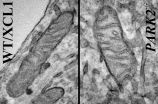A new breakthrough in thermoelectric materials
2015-04-02
(Press-News.org) French physicist Jean Charles Athanase Peltier discovered a key concept necessary for thermoelectric (TE) temperature control in 1834. His findings were so significant, TE devices are now commonly referred to Peltier devices. Since his work, there have been steady advancements in materials and design. Despite the technological sophistication Peltier devices, they are still less energy efficient than traditional compressor/evaporation cooling.
In the 1960's, Peltier devices were primarily made from Bismuth-Telluride (Bi2Te3) or Antimony-Telluride (Sb2Te3) alloys and had a peak efficiency (zT) of 1.1, meaning the electricity going in was only slightly less than the heat coming out. Since the 1960's there have been incremental advancements in alloy technology used in Peltier devices.
In 2014, researchers in South Korea at IBS Center for Integrated Nanostructure Physics along with Samsung Advanced Institute of Technology, the Department of Nano Applied Engineering at Kangwon National University, the Department of Energy Science at Sungkyunkwan University, and Materials Science department at California Institute of Technology California, USA have formulated a new method for creating a novel and much more efficient TE alloy.
TE alloys are special because the metals have an incredibly high melting point. Instead of melting the metals to fuse them, they are combined through a process called sintering which uses heat and/or pressure to join the small, metallic granules. The joint team, including IBS researchers, used a process called liquid-flow assisted sintering which combined all three antimony, bismuth and telluride granules into one alloy (Bi0.5Sb1.5Te3). Additional melted tellurium was used as the liquid between the Bi0.5Sb1.5Te3 granules to help fuse them into a solid alloy, and excess Te is expelled in the process.
By creating the alloy this way, the joints between the fused grains, also known as the grain boundaries, took on a special property. Traditionally sintered Bi0.5Sb1.5Te3 have thick, coarse joints which have led to a decrease in both thermal and electrical conductivity. The new liquid-phase sintering creates grain boundaries which are organized and aligned in seams called dislocation arrays. These dislocation arrays greatly reduce their thermal conduction, leading to an enhancement of their thermoelectric conversion efficiency.
In tests, the efficiency (zT) reached 2.01 at 320 K within the range of 1.86 ±0.15 at 320 K (46.85° C) for 30 samples, nearly doubling the industry standard. When the melt spun Bi0.5Sb1.5Te3 alloy is used in a Peltier cooler, the results are also significant. The new material was able achieve a temperature change of 81 K at 300 K (26.85° C).
The applications for such a material are abundant. As new fabrication techniques are developed, Peltier cooling devices may be used in place of traditional compression refrigeration systems. More importantly, as electrical vehicles and personal electronic devices become more ubiquitous in our daily lives, it is becoming increasingly necessary to have more efficient systems for localized electrical power generation and effective cooling mechanisms. This new thermoelectric alloy paves the way for the future of modern TE devices.
INFORMATION:
[Attachments] See images for this press release:

ELSE PRESS RELEASES FROM THIS DATE:
2015-04-02
MIAMI - A first-of-its-kind study observed how oil droplets are formed and measured their size under high pressure. They further simulated how the atomized oil spewing from the Macondo well reached the ocean's surface during the Deepwater Horizon accident. The findings from the University of Miami (UM) Rosenstiel School of Marine and Atmospheric Science and University of Western Australia research team suggest that the physical properties in deep water create a natural dispersion mechanism for oil droplets that generates a similar effect to the application of chemical ...
2015-04-02
Binge-drinking during adolescence may perturb brain development at a critical time and leave lasting effects on genes and behavior that persist into adulthood.
The findings, by researchers at the University of Illinois at Chicago College of Medicine using an animal model, are reported online in the journal Neurobiology of Disease.
"This may be the mechanism through which adolescent binge-drinking increases the risk for psychiatric disorders, including alcoholism, in adulthood," says lead author Subhash Pandey, professor of psychiatry and director of neuroscience alcoholism ...
2015-04-02
Irvine, Calif. -- A newly developed website provides parents and children with individualized information and support -- based on factors like coping style and levels of worry and fear -- to help lower anxiety before outpatient surgery in children, according to a pair of articles in the April issue of Anesthesia & Analgesia.
The papers report on the development of the "Web-based Tailored Intervention Preparation for Surgery" (WebTIPS) project, which provides information and strategies to help children and parents prepare for surgery and anesthesia. A preliminary evaluation ...
2015-04-02
Based on research in fruit flies, it has long been suspected that the most common mutation linked to both sporadic and familial Parkinson's disease (PD) wreaks its havoc by altering the function of mitochondria in neurons that produce the neurotransmitter dopamine. Using stem cells derived from patients who have PD, scientist at the Buck Institute have confirmed that finding in human cells for the first time. In research published in the April 2nd early online edition of Stem Cell Reports, Buck researchers also provide a valuable tool for testing potential treatments ...
2015-04-02
BOSTON -- Pseudogenes, a sub-class of long non-coding RNA (lncRNA) that developed from the genome's 20,000 protein-coding genes but lost the ability to produce proteins, have long been considered nothing more than genomic "junk." Yet the retention of these 20,000 mysterious remnants during evolution has suggested that they may in fact possess biological functions and contribute to the development of disease.
Now, a team led by investigators in the Cancer Research Institute at Beth Israel Deaconess Medical Center (BIDMC) has provided some of the first evidence that one ...
2015-04-02
The ability to learn associations between events is critical for survival, but it has not been clear how different pieces of information stored in memory may be linked together by populations of neurons. In a study published April 2nd in Cell Reports, synchronous activation of distinct neuronal ensembles caused mice to artificially associate the memory of a foot shock with the unrelated memory of exploring a safe environment, triggering an increase in fear-related behavior when the mice were re-exposed to the non-threatening environment. The findings suggest that co-activated ...
2015-04-02
(Boston)--Using patient-derived stem cells known as induced pluripotent stem cells (iPSC) to study the genetic lung/liver disease called alpha-1 antitrypsin (AAT) deficiency, researchers have for the first time created a disease signature that may help explain how abnormal protein leads to liver disease.
The study, which appears in Stem Cell Reports, also found that liver cells derived from AAT deficient iPSCs are more sensitive to drugs that cause liver toxicity than liver cells derived from normal iPSCs. This finding may ultimately lead to new treatments for the condition.
IPSC's ...
2015-04-02
Capitalizing on a rare opportunity to thoroughly analyze a tumor from a lung cancer patient who had developed resistance to targeted drug treatment, UC San Francisco scientists identified a biological escape hatch that explains the resistance, and developed a strategy in mice for shutting it down.
In experiments that combined the drug the patient had taken with a second compound that blocks off this newly discovered resistance pathway, the researchers were able to durably wipe out cancer cells in mice implanted with cells from the drug-resistant tumor.
"Even in cancers ...
2015-04-02
CANCER RESEARCH UK scientists have discovered that a vital self-destruct switch in cells is hijacked - making some pancreatic and non small cell lung cancers more aggressive, according to research published in Cancer Cell today (Thursday)*.
The team, from the Cancer Research UK Centre at the UCL (University College London) Cancer Institute, found that mutations in the KRAS gene interferes with protective self-destruct switches, known as TRAIL receptors, which usually help to kill potentially cancerous cells.
The research, carried out in cancer cells and mice, shows ...
2015-04-02
Researchers have identified a new genetic mutation at the heart of a severe and potentially deadly seizure disorder found in infants and young children. The finding, which was reported today in the journal American Journal of Human Genetics, may help scientists unravel the complex biological mechanism behind these diseases.
"These findings allow us to open up what was, up to this point, a 'black box' and more fully understand the biological pathways associated with these disorders and why some individuals do not respond to treatment," said Alex Paciorkowski, M.D., an ...
LAST 30 PRESS RELEASES:
[Press-News.org] A new breakthrough in thermoelectric materials


